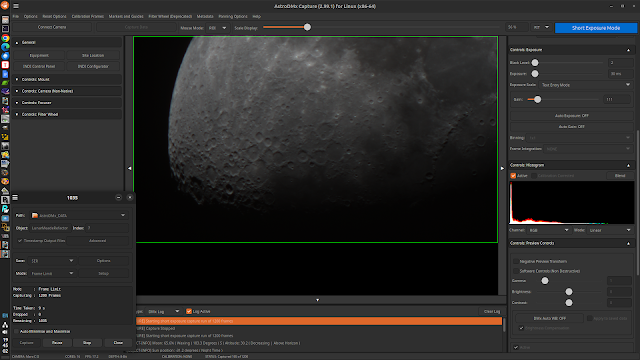Four nebulae were Captured with AstroDMx Capture, controlling the mount via a newly implemented INDIGO client. The scope was an Altair Starwave 60 ED refractor with an 0.8 reducer/flattener, an Altair Quadband filter and an SVBONY SV605CC 14 bit OSC CMOS camera. We were testing Nicola's implementation of the INDIGO client. PHD2 pulse auto-guiding was also done via INDIGO. The mount was placed on marks on the ground which quickly gives quite a good polar alignment if care is taken with the placement of the tripod feet.
AstroDMx Capture running on the imaging computer indoors sent the scope/mount, via an INDIGO server running on the same computer, to Vega and the scope was focused on the star using a Bahtinov mask and the Pegasus focuser.
An SVBONY SV165 guide scope with a QHY-5II-M guide camera was used for PHD2 multistar pulse auto-guiding. The auto-guiding was controlled by a separate Linux laptop indoors via the INDIGO server
The exposures for each nebula were:
Heart 18 x 5 min = 90 minutes
Soul 14 x 5 min = 70 minutes
Pacman 17 x 5 min = 85 minutes
Helix 30 x 2.5 min = 75 minutes
The images were calibrated and stacked in Deep Sky Stacker, background corrected in GraXpert and post processed in the Gimp 2.10, the Starnet++ Gimp plugin, Neat image and CS2. Channel decomposition, combining and composition, selective colours processing and Channel mixing were used to produce an HOO type palette rendering of the Heart and Soul nebulae.
The Heart nebula
AstroDMx Capture capturing data on the Heart nebula
Negative preview
The Heart nebula
HOO type rendering
The Soul nebula
AstroDMx Capture capturing data on the Soul nebula
Negative preview
The Soul nebula
HOO type rendering
The Pacman nebula
AstroDMx Capture capturing data on the Pacman nebula
Negative preview
The Pacman nebula
The Helix nebula
AstroDMx Capture capturing data on the Helix nebula
Negative preview
The Helix nebula
The session was a success. The few anomalies that were detected were noted and have been resolved.
INDIGO support is getting closer to release.





































